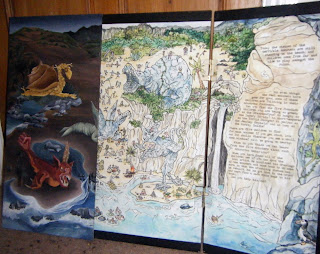
This is what I did for our major assessment at the end of first year, and it's basically a kind of Where's Wally meets early Christian altar/panel paintings (there's a definite gap in the market for this kind of thing). It's a fold-out educational triptych, based on the 'Monster's Park' entry in The Dictionary of Imaginary Places.
The story goes that one day Alexander the Great decides to build the city of Alexandria on a beach in Egypt. Only he has some trouble with these sea monsters, who come out onto the beach every night and keep destroying the foundations. So Alexander sends an artist down into the sea in a glass box to sketch the monsters, and these sketches are used to make giant replica statues of the monsters on the beach, facing the sea. So the next day when the monsters come up to cause some more destruction, they see the statues of themselves, which are so scary that they go back into the sea forever.
But that was a long time ago, and nowadays the children of Alexandria happily play amongst the ruins of these massive scary stone monsters.

(above) - triptych when folded up - painting of the five monsters terrorising the beach.
(below) - inside of triptych - the beach as it is today, with children playing on the ruins.

What I did for the project was to give the monsters silly names and make up a story about how they each embodied a different deadly sin. There was the Jeasley Kephals (envy), the Gastry Havity (gluttony), the Torrid Storgon (wrath), the Graspacarpus (greed) and a personal favourite - the Knobby Snidle (sloth)... (sadly I did not incorporate lust or pride into proceedings). And now some of the children who come to play in Monster's Park are "following in their monstrous footsteps" and behaving angrily, jealously, greedily, etc.
There are five children to find for each sin (25 overall), as well as the artist who did the sketches, who got lost and needs to find a way back to his boat. The point of all this was I think to educate kids about allegory and metaphors, as well as the importance of not being as badly behaved as these sinful and aptly-named monsters!



My main inspiration for this was Hieronymous Bosch's The Garden of Earthly Delights, which is also a triptych featuring nightmarish imagery and a moral commentary, and is almost as good as mine.

No comments:
Post a Comment